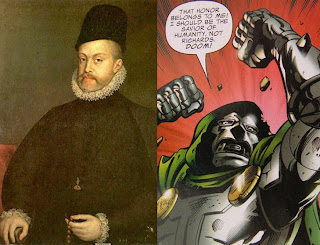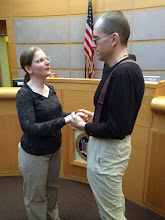
In issues 551 through 553 of The Fantastic Four, the FF get a surprise visit from a future version of their oldest nemesis: Victor von Doom, aka Doctor Doom. Doom has traveled back in time on a purportedly benevolent mission: to warn the team that Reed Richards will go mad with power, and that this will have disastrous consequences for the entire planet. Under normal circumstances the FF wouldn't believe Doom for a second, but they've recently been shaken to their foundations by the events of the Marvel Universe's Civil War, in which Reed made some choices that caused most of the world to lose faith in him. They listen to what Doom has to say, more or less, and then a time portal opens and their future selves - the FF from the future Doom's timeline - show up. They want to take Doom back with them, but the present-day Reed, allowing for the possibility that what Doom says is true, decides to protect Doom. Arguments - and eventually fighting - ensue between "our" FF and their future selves: not simply because the future FF want Doom, but because they remember a version of history where they fought their future selves, and this is all part of preserving the time stream! Eventually the fighting subsides as the present-day FF learn the truth. Here's the conversation between Ben Grimm, the future Doom, Sue Richards, and the future Reed Richards.
Ben:
You guys are tryin' to keep things the way they were, but Doomsie... is trying ta change history.
Doom:
As I said. To prevent Reed's madness from destroying the future.
Sue:
Destroying it how, Victor? You say you're a man of honor... tell us the truth. What's the world like where you come from?
Doom:
...
Paradise.
It's paradise.
His dual-layer Dyson swarm provides nearly free and inexhaustible energy. Advances in medicine have greatly extended both the duration and quality of life. There hasn't been a war in over 40 years, hunger and crime are all but unknown, education is universal. Art thrives.
Reed:
There's still a lot of work to do, but --
Doom:
But humanity is safe, happy, prosperous and striving for true greatness.
And it's all Richards's fault.
Ben:
Fault? Are you out of yer blamed mind?
Doom:
That honor belongs to me! I should be the savior of humanity, not Richards. Doom!
Reed:
Now you know the truth. Doom came back to the past, intending to correct history so that the future would be the product of his hand.
Fun story, huh? Well, I sure enjoyed it. But it's not just a story.
In 1571 a Christian naval coalition defeated a large Ottoman force at the Battle of Lepanto. The unprecedented cooperation between Western Christian states shows how dire the Ottoman threat had become. Had the battle gone slightly differently, the Christian forces would have been enveloped by the larger Ottoman force and crushed, leaving the eastern Mediterranean and much of eastern Europe open to further encroachment. One would think that any Christian would have felt unalloyed joy at news of the victory, let alone the king of one of the main countries involved. In my experience, though, you can always count on Philip II to behave enigmatically. First, let's put Philip's Catholic faith into perspective. The following is from page 27 of David Howarth's The Voyage of the Armada: The Spanish Story.
But it was not only a political empire; it was also a religious entity, and that was what made it so complex. King Philip was His Most Catholic Majesty. He believed he was appointed by god to defend the truth against infidels and heretics. The pope was Vicar of Christ: Philip, in his own eyes, was Champion of god, the equal of the pope in God's designs. In this sense, his boundaries were vague. There were people all over Europe, caught in the ebb and flow of Reformation and Counter-Reformation, whose loyalties were divided between their country and their church. In almost all of Philip's Catholic domains, Protestants had been exterminated, or pushed far under ground, by the Inquisition. The only exception was the Netherlands. All through his reign they had been in revolt, partly against the shame of foreign rule and partly to protect their Protestant creed: he had to keep an immensely expensive army there, and it had never succeeded in putting the rebels down. But he was not only concerned with his own domains. It was his personal duty, divinely imposed as he believed, to punish Protestants everywhere and rescue Catholics who lived under Protestant rule.Now, on to Philip's reaction to Lepanto in 1571. The following is from page 294 of Victory of the West by Niccolo Capponi.
Despite his apparent elation over the Christian victory, the king was not totally happy about the league's success. Don Juan had put the Habsburg galleys and soldiers at considerable risk by deciding to join battle - a rash decision to say the least, especially for el rey prudente, and according to a number of Philip's councillors the prince could only thank God if he had come out of it alive. Significantly, the king commissioned only one work of art to commemorate the victory - Titian's Philip II, after the victory of Lepanto, offers the prince Don Fernando to victory, now in the Prado - and to celebrate more the continuity of the Habsburg line than the Ottoman defeat. The six large canvases of the battle by Luca Cambiaso, now in the Escorial, were probably gifts of Giovanni Andrea Doria to the royal secretary Antonio Pérez, acquired by the king at a later date. One has the distinct impression that for Philip the league victory represented a potential source of political trouble, possibly because by weakening the Porte's navy it had altered the balance of power in the Mediterranean and loosened Spain's grip on Italy.This utterly amazed me when I first read it, and it still makes my jaw slacken a bit. Philip II was the model of a Catholic King of the sixteenth century: as relentless as he was devout. Yet upon hearing of the greatest Catholic victory of his age, his reaction was lukewarm. It didn't matter to him that Christian forces won, as long as he wasn't in control. Even if everything happened that he wanted to happen, it didn't matter as long as it wasn't by his hand. Sound familiar?
The best stories aren't just stories. They're history.
Thanks to Grace for giving me the idea for this entry. It still amazes me that I didn't think of it, seeing as how I was the one who told her about this aspect of Philip's personality.














